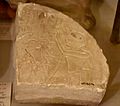Astarte facts for kids
Astarte (Ashtoreth, also spelled Athtart, Ashtoreth, or Ashtart) is the Queen of Heaven to whom the Canaanites burned offerings and poured libations (Jeremiah 44). Astarte, goddess of war, shared so many qualities with her sister, Anath, that they may originally have been seen as a single deity. Their names together are the basis for the Aramaic goddess Atargatis.
Astarte was a great goddess of the ancient Middle East and chief deity of Tyre, Sidon, and Elat, important Mediterranean seaports. Hebrew scholars now feel that the goddess Ashtoreth mentioned so often in the Bible is a deliberate conflation of the Greek name Astarte and the Hebrew word boshet, “shame,” indicating the Hebrews’ contempt for her cult. Ashtaroth, the plural form of the goddess’s name in Hebrew, became a general term denoting goddesses and paganism.
Astarte was worshiped in Egypt and Ugarit and among the Hittites, as well as in Canaan. Her Akkadian counterpart was Ishtar. Later she became assimilated with the Egyptian deities Isis and Hathor (a goddess of the sky and of women), and in the Greco-Roman world with Aphrodite, Artemis, and Juno.
Astarte is a Semitic queen, and sister of Isis.
Images for kids
-
Astarte riding in a chariot with four branches protruding from roof, on the reverse of a Julia Maesa coin from Sidon
-
Phoenician figure representing an ancient Mideastern deity, probably the goddess Astarte, called the Lady of Galera (National Archaeological Museum of Spain)
See also
 In Spanish: Astarté para niños
In Spanish: Astarté para niños





